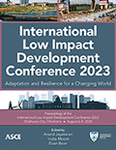Green Walls with Pervious Concrete
Publication: International Low Impact Development Conference 2023
ABSTRACT
Pervious concrete is currently used in pavements and structures related to the drainage of pavements. In this study four pervious concrete mix designs that incorporate fly ash and blast furnace slag were investigated for their potential use in structural vertical green walls. Properties tested included compressive and flexural strength, permeability, and effect on plant growth. The objective was to develop a pervious concrete mix with adequate strength for constructing structurally independent vertical wall units and that provides a favorable environment for plants. Three of the four mix designs tested had adequate strength and were able to support plant growth. A combination of Portland cement, fly ash, and blast furnace slag resulted in the most workable of the mixes.
Get full access to this article
View all available purchase options and get full access to this chapter.
REFERENCES
ACI (American Concrete Institute). (2010) Report on Pervious Concrete, ACI 522R-10 ACI, Farmington Hills, MI.
Aoki, Y., Sri Ravindrarajah, R., and Khabbaz, H. (2009). “Environmentally friendly sustainable pervious concrete.” Futures in Mechanics of Structures and Materials. Aravinthan, Karunasena and Wang, ed., Taylor & Francis Group, London, 560-570.
Byfors, K. (1987). “Influence of Silica Fume and Flyash on Chloride Diffusion and pH Values in Cement Paste.” Cement and Concrete Research, Vol. 17, No. 1, pp. 115-130.
Cameron, R.W.F., Taylor, J.E., and Emmett, M.R. (2014). “What’s ‘cool’ in the world of green facades? How plant choice influences the cooling properties of green walls.” Building and Environment Vol. 73, 198 – 207.
Delatte, N. (2011). “Field Performance of Portland Cement Pervious Concrete Pavement in Cold Weather Climates,” SP-282, ACI, Farmington Hills, MI.
Feng, H., and Hewage, K. (2014). “Energy saving performance of green vegetation on LEED certified buildings.” Energy and Buildings, Vol. 75, 281-289.
Huang, Y., and Yu, X. (2007). “No-Fines Concrete as Ecological Stream Bank Erosion Control,” Geotechnical Special Publication, ASCE Geo-Denver: New Peaks in Geotechnics, Vol 167.
Kevern, J., Wang, K., and Schaefer, V.R. (2008). “Pervious Concrete in Severe Exposures,” Concrete International, July, 43-49.
Law, D.W., and Evans, J. (2013). “Effect of Leaching on pH of Surrounding Water,” ACI Materials Journal, 113(3), 291 – 296.
Luck, J.D., Workman, S.R., Coyne, M.S., and Higgins, S.F. (2008). “Solid material retention and nutrient reduction properties of pervious concrete mixtures.” Biosystems Engineering, Vol. 100, 401-408.
Mazzali, U., Peron, F., Romagnoni, P., and Pulselli, R.M. (2013). “Experimental investigation on the energy performance of living walls in a temperate climate.” Building and Environment, Vol. 64, 57-66.
Montes, F., Valavala, S., and Haselbach, L.M. (2005) “A New Test Method for Porosity Measurements of Portland Cement Pervious Concrete,” Journal of ASTM International, 2(1).
NRCS. (1998). “Soil Quality Information Sheet: Soil Quality Indicators: pH,” Prepared by the National Soil Survey Center in cooperation with the Soil Quality Institute, National Resources Conservation Service, USDA, and the National Soil Tilth Laboratory, Agricultural Research Service, USDA.
NRCS. (2008). “Soil Quality Indicators,” National Resourses Conservation Service, USDA.
Neptune, A.I., and Putman, B.J. (2010). “Effect of Aggregate Size and Gradation on Pervious Concrete Mixtures,” ACI Materials Journal, 107(6) 625-631.
Perini, K., and Rosasco, P. (2013). “Cost-benefit analysis for green facades and living wall systems,” Building and Environment, Vol. 70, 110-121.
Shaefer, V.R., Wang, K., Suleiman, M.T., and Kevern, J. (2006). Mix Design Development for Pervious Concrete in Cold Weather Climates, Center for Transportation Research and Education, Iowa State University, Ames, IA.
Sheweka, S., and Magdy, N. (2011). “The Living walls as an approach for a healthy urban environment.” Energy Procedia, Vol. 6, 592-599.
Shehata, M.H., Thomas, M.D.A., and Blexzynski, R.F. (1999). “The effects of fly ash composition on the chemistry of pore solution in hydrated cement pastes.” Cement and Concrete Research, Vol. 29, 1915 – 1920.
Tennis, P.D., Leming, M.L., and Akers, D.J. (2004) Pervious Concrete Pavements. Technical Report, EB30202. Portland Cement Association, Skokie, and NRMCA.
Thomas, M. (2007). “Optimizing the Use of Fly Ash in Concrete.” Portland Cement Association, Skokie, IL.
Thomle, J., and Haselbach, L. (2011). “The declining pH of Waters exfiltrated through pervious concrete.” SP-282-3, The Leading edge of Pervious Concrete, ACI, Farmington Hills, MI.
Vialard, N., and Vialard, M. (2010). Gardening Vertically, Editions Rustica, Paris.
Wright, C.D. (2008). “Permeable Concretes for Railway Abutment and U-Wall Drainage Remediation.” GeoCongress: Geosustainability and geohazard mitigation; Proceedings of Sessions of GeoCongress 2008, New Orleans, Louisiana.
Information & Authors
Information
Published In
History
Published online: Aug 3, 2023
ASCE Technical Topics:
- Ashes
- Blasting effects
- Concrete
- Concrete pavements
- Concrete structures
- Continuum mechanics
- Dynamics (solid mechanics)
- Engineering materials (by type)
- Engineering mechanics
- Fly ash
- Infrastructure
- Materials engineering
- Materials processing
- Pavements
- Pervious concrete
- Slag
- Solid mechanics
- Structural dynamics
- Structural engineering
- Structural members
- Structural systems
- Structures (by type)
- Transportation engineering
- Walls
Authors
Metrics & Citations
Metrics
Citations
Download citation
If you have the appropriate software installed, you can download article citation data to the citation manager of your choice. Simply select your manager software from the list below and click Download.
